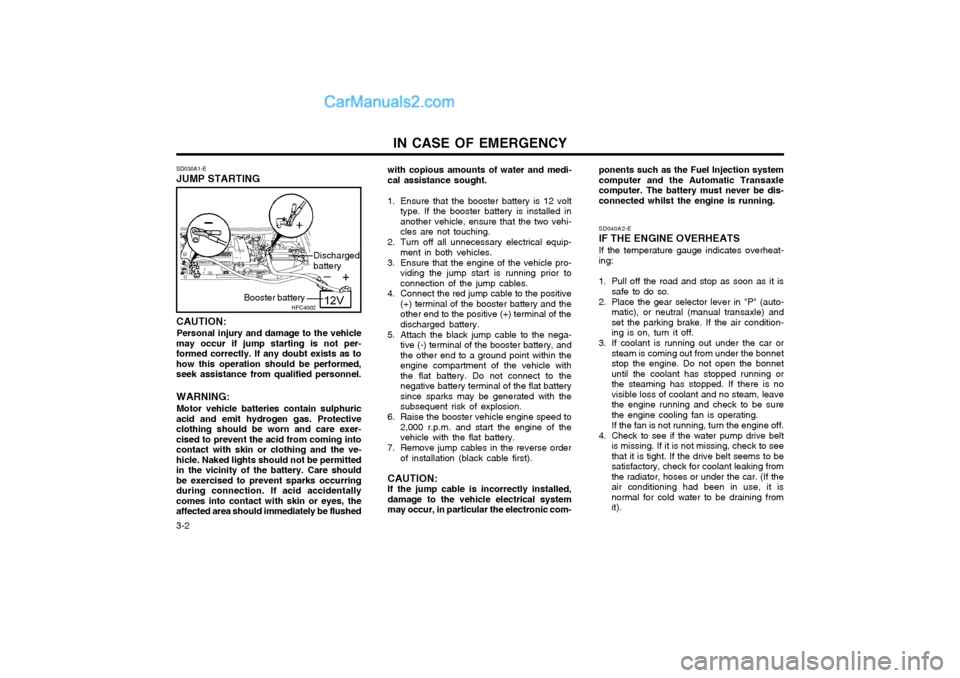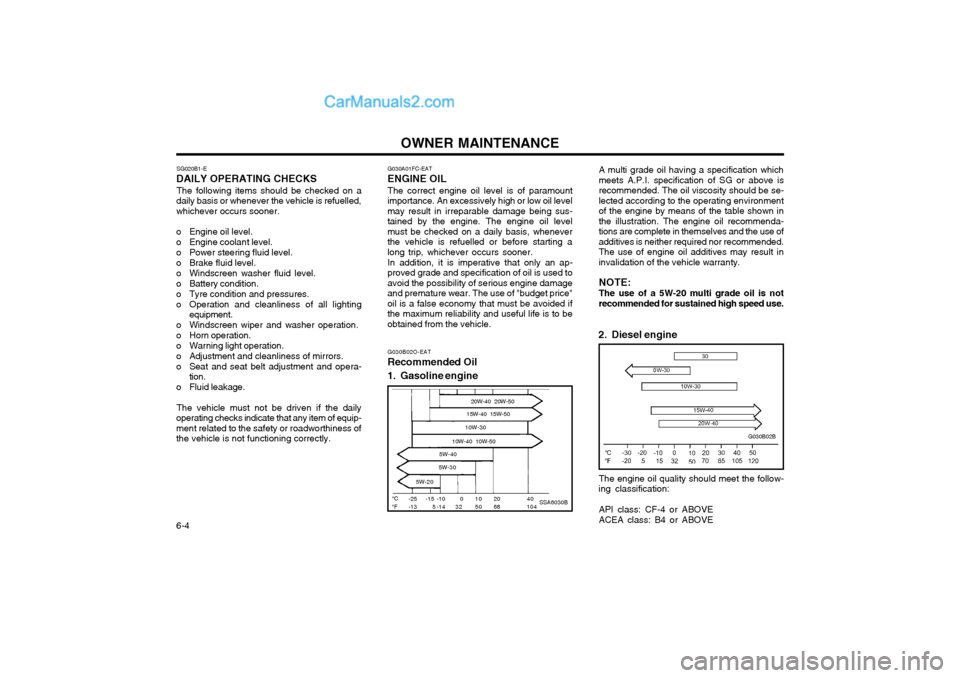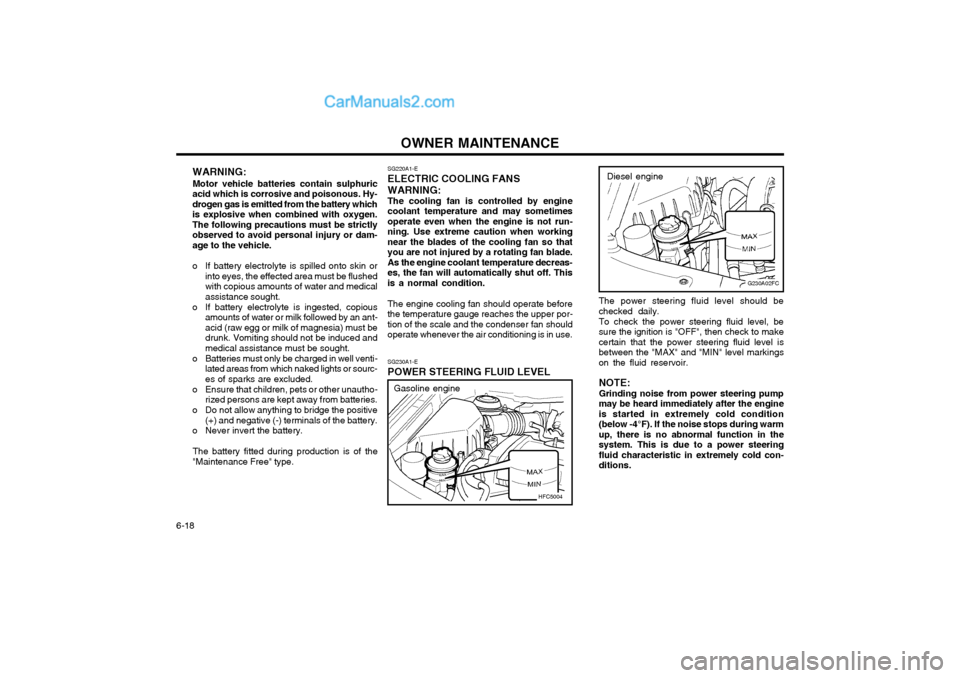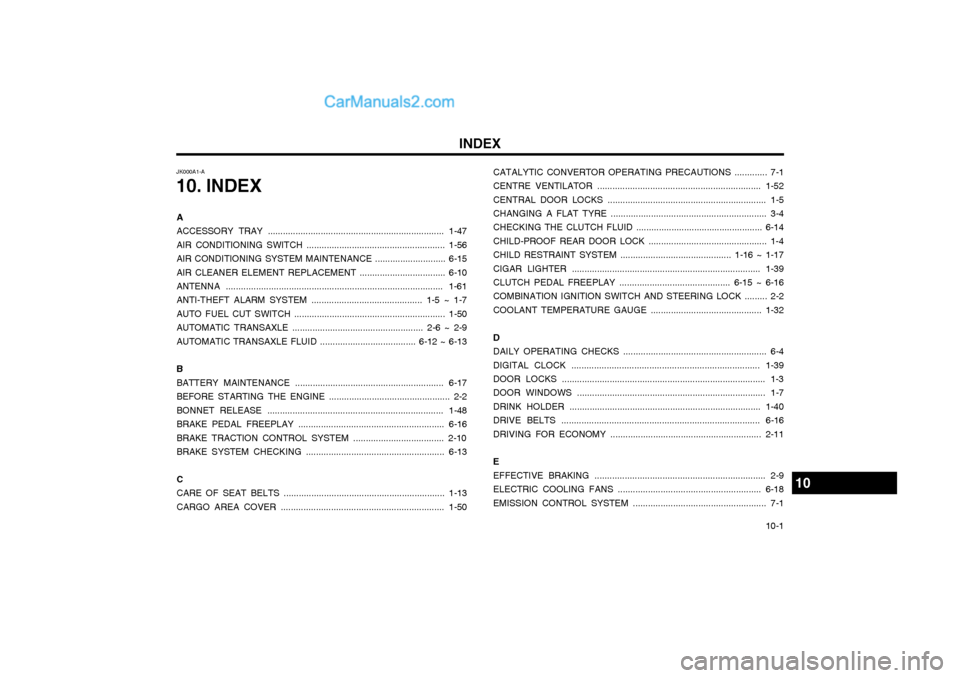check engine light Hyundai Matrix 2003 Owner's Guide
[x] Cancel search | Manufacturer: HYUNDAI, Model Year: 2003, Model line: Matrix, Model: Hyundai Matrix 2003Pages: 312, PDF Size: 4.1 MB
Page 257 of 312

DRIVING YOUR HYUNDAI 2- 15
5. Always secure items in the trailer to pre-
vent load shift while driving.
6. Check the condition and air pressure of all tyres on the trailer and your car. Low tyre pressure can seriously affect the handling.Also check the spare tyre.
7. The vehicle/trailer combination is more af- fected by crosswind and buffeting. When being passed by a large vehicle, keep a constant speed and steer straightahead. If there is too much wind buffetingslow down to get out of the other vehicle'sair turbulence.
8. When parking your car and trailer, espe- cially on a hill, be sure to follow all thenormal precautions. Turn your front wheelinto the curb, set the parking brake firmly,and put the transaxle in 1st or Reverse(manual) or Park (automatic). In addition,place wheel chocks at each of the trailer'styres.
9. If the trailer has electric brakes, start your vehicle and trailer moving, and then applythe trailer brake controller by hand to besure the brakes are working. This lets youcheck your electrical connection at thesame time.
10.During your trip, check occasionally to be sure that the load is secure, and that thelights and any trailer brakes are still work-ing. 11.Avoid jerky starts, sudden acceleration or
sudden stops.
12.Avoid sharp turns and rapid lane changes.
13.Avoid holding the brake pedal down too long or too frequently. This could cause the brakes to overheat, resulting in re-duced braking efficiency.
14.When going down a hill, shift into a lower gear and use the engine braking effect. When ascending a long grade, downshift the transaxle to a lower gear and reducespeed to reduce chances of engine over-loading and/or overheating.
15.If you have to stop while going uphill, do not hold the vehicle in place by pressing onthe accelerator. This can cause the auto-matic transaxle to overheat. Use the park-ing brake or footbrake.
NOTE: When towing check transaxle fluid more frequently. CAUTION: If overheating should occur when towing,(temperature gauge reads near red zone),taking the following action may reduce oreliminate the problem.
1. Turn off the air conditioner.
2. Reduce highway speed.
3. Select a lower gear when going uphill.
4. While in stop and go traffic, place the gear selection in park or neutral and idle the engine at a higher speed.
Page 258 of 312

3-1
IN CASE OF EMERGENCY
SD000A1-E
3. IN CASE OF
EMERGENCY
SD020A1-E
IF THE ENGINE WILL NOT START Seek assistance from the nearest Hyundai dealer with regard to the method of ignition andfuel system diagnosis.
CAUTION:If the engine refuses to start, no attempt
should be made to push or tow start thevehicle. Vehicles with automatic transaxleor fuel injection will not be able to bestarted in this manner since no drive istransmitted through the automatic transaxlewhilst the engine is not running, and in thecase of fuel injected derivatives, the fuelpump will not operate under tow start con-ditions. In addition, if the vehicle isequipped with an exhaust catalyst, dam-age to the catalyst may result if the vehicleis tow started. SD020B1-E
IF THE ENGINE CANNOT BE
CRANKED SD020C1-F
If Engine Turns Over Normally but Does Not Start
SSA3020C
1. Check fuel Level
2. Check all connectors at ignition coil and spark plugs.Replace any that may be disconnected or loose.
3. Check fuel line in the engine room.
4. If engine still refuses to start, call a Hyundai dealer or seek other qualified assistance.
1. If the vehicle is fitted with manual transaxle,
ensure that the clutch pedal is depressed whilst cranking the engine. If the vehicle isfitted with automatic transaxle, ensurethat the transaxle selector is at the "P"or"N" position.
2. Check the battery terminals and connec- tions to ensure that these are clean andalso tight.
3. If the ignition warning lights dim when the engine is cranked and the battery termi-nals have been checked, a dischargedbattery is indicated.
4. Do not attempt to push or tow start the vehicle, refer to "Jump Starting" for infor-mation regarding engine starting when thebattery is discharged. AD020D1-A
If Engine Stalls While Driving
1. Reduce your speed gradually, keeping a straight line. Move cautiously off the road to a safe place.
2. Turn on your emergency flashers.
3. Try starting the engine again. If your ve- hicle will not start, see "IF THE ENGINE WILL NOT START"
3
D010B01FC
Page 259 of 312

IN CASE OF EMERGENCY
3-2
CAUTION:
Personal injury and damage to the vehicle
may occur if jump starting is not per- formed correctly. If any doubt exists as tohow this operation should be performed,seek assistance from qualified personnel. WARNING:
Motor vehicle batteries contain sulphuric
acid and emit hydrogen gas. Protective clothing should be worn and care exer-cised to prevent the acid from coming intocontact with skin or clothing and the ve-hicle. Naked lights should not be permittedin the vicinity of the battery. Care shouldbe exercised to prevent sparks occurringduring connection. If acid accidentallycomes into contact with skin or eyes, theaffected area should immediately be flushed ponents such as the Fuel Injection system
computer and the Automatic Transaxlecomputer. The battery must never be dis-connected whilst the engine is running. SD040A2-E IF THE ENGINE OVERHEATS If the temperature gauge indicates overheat- ing:
1. Pull off the road and stop as soon as it is
safe to do so.
2. Place the gear selector lever in "P" (auto- matic), or neutral (manual transaxle) and set the parking brake. If the air condition-ing is on, turn it off.
3. If coolant is running out under the car or steam is coming out from under the bonnetstop the engine. Do not open the bonnetuntil the coolant has stopped running orthe steaming has stopped. If there is novisible loss of coolant and no steam, leavethe engine running and check to be surethe engine cooling fan is operating. If the fan is not running, turn the engine off.
4. Check to see if the water pump drive belt is missing. If it is not missing, check to see that it is tight. If the drive belt seems to besatisfactory, check for coolant leaking fromthe radiator, hoses or under the car. (If theair conditioning had been in use, it isnormal for cold water to be draining fromit).
SD030A1-E JUMP STARTING
with copious amounts of water and medi- cal assistance sought.
1. Ensure that the booster battery is 12 volt type. If the booster battery is installed inanother vehicle, ensure that the two vehi-cles are not touching.
2. Turn off all unnecessary electrical equip- ment in both vehicles.
3. Ensure that the engine of the vehicle pro- viding the jump start is running prior toconnection of the jump cables.
4. Connect the red jump cable to the positive (+) terminal of the booster battery and theother end to the positive (+) terminal of thedischarged battery.
5. Attach the black jump cable to the nega- tive (-) terminal of the booster battery, andthe other end to a ground point within theengine compartment of the vehicle withthe flat battery. Do not connect to thenegative battery terminal of the flat batterysince sparks may be generated with thesubsequent risk of explosion.
6. Raise the booster vehicle engine speed to 2,000 r.p.m. and start the engine of thevehicle with the flat battery.
7. Remove jump cables in the reverse order of installation (black cable first).
CAUTION:If the jump cable is incorrectly installed,damage to the vehicle electrical systemmay occur, in particular the electronic com-
HFC4002
Booster battery Discharged battery
Page 279 of 312

OWNER MAINTENANCE
6-4
SG020B1-E
DAILY OPERATING CHECKS
The following items should be checked on a
daily basis or whenever the vehicle is refuelled, whichever occurs sooner.
o Engine oil level.
o Engine coolant level.
o Power steering fluid level.
o Brake fluid level.
o Windscreen washer fluid level.
o Battery condition.
o Tyre condition and pressures.
o Operation and cleanliness of all lighting equipment.
o Windscreen wiper and washer operation.
o Horn operation.
o Warning light operation.
o Adjustment and cleanliness of mirrors.
o Seat and seat belt adjustment and opera- tion.
o Fluid leakage.
The vehicle must not be driven if the daily
operating checks indicate that any item of equip- ment related to the safety or roadworthiness ofthe vehicle is not functioning correctly. G030A01FC-EAT
ENGINE OIL
The correct engine oil level is of paramount
importance. An excessively high or low oil levelmay result in irreparable damage being sus-tained by the engine. The engine oil levelmust be checked on a daily basis, wheneverthe vehicle is refuelled or before starting along trip, whichever occurs sooner.
In addition, it is imperative that only an ap-
proved grade and specification of oil is used toavoid the possibility of serious engine damageand premature wear. The use of "budget price"oil is a false economy that must be avoided ifthe maximum reliability and useful life is to beobtained from the vehicle.
G030B02O-EAT
Recommended Oil
1. Gasoline engine
20W-40 20W-50
5W-40
SSA6030B
°C °F -25 -13 40104
2068
1050
032
-15 5 -10-14
5W-20 15W-40 15W-50
10W-30
10W-40 10W-50
5W-30
A multi grade oil having a specification which meets A.P.I. specification of SG or above isrecommended. The oil viscosity should be se-lected according to the operating environmentof the engine by means of the table shown inthe illustration. The engine oil recommenda-tions are complete in themselves and the use ofadditives is neither required nor recommended.The use of engine oil additives may result ininvalidation of the vehicle warranty. NOTE: The use of a 5W-20 multi grade oil is not recommended for sustained high speed use.
2. Diesel engine
The engine oil quality should meet the follow-
ing classification:
API class: CF-4 or ABOVEACEA class: B4 or ABOVE
G030B02B
Page 288 of 312

OWNER MAINTENANCE 6-13
dipstick is thoroughly clean prior to level checking or adding fluid.
SG120D1-E
Brake Fluid Level
The fluid level in the brake fluid reservoir
should be checked periodically. The levelshould be between the "MIN" and "MAX"marks on the side of the reservoir. If the levelis at or below the "MIN" mark, fluid should beadded having carefully cleaned the area sur-rounding the reservoir cap to ensure that dirtis not allowed to enter the system. It shouldbe borne in mind that the brake fluid level willdecrease slightly as the friction linings of thepads and shoes become worn and that this isa normal condition.
SG120A1-E
BRAKE SYSTEM CHECKING CAUTION:
Correct operation of the braking system is
essential to the safe operation of the vehicle and therefore, any maintenance operationsother than those listed below should beentrusted to a Hyundai dealer.
SG120C2-E
Brake Fluid Recommendations Only brake fluid conforming to DOT 3 or
DOT 4 specifications or higher may be usedin the braking system. Care should be takento observe the instructions and precautionsprinted upon the container.
Fluid level should be within this range
C090A03FC
�Î�Î
HFC5005
Gasoline engine
WARNING: The cooling fan is controlled by engine
coolant temperature and may sometimesoperate even when the engine is not run-ning. Use extreme caution when workingnear the blades of the cooling fan so thatyou are not injured by a rotating fan blade.As the engine coolant temperature de-creases, the fan will automatically shutoff. This is a normal condition.
WARNING (Diesel only): Never work on injection system with en-
gine running or within 30 seconds after shutting off engine. High pressure pump,rail, injectors and high pressure pipes aresubject to high pressure even after theengine stopped. The fuel jet produced byfuel leaks may cause serious injury, if it touch the body. People using pacemak-ers should not move than 30cm closer tothe ECU or wiring harness within theengine room while engine is running,since the high currents in the CommonRail system produce considerable mag-netic fields. Fluid Capacity
The total fluid capacity of the transmission unit
is 6.1 litres (1.6 DOHC)/6.7 litres(1.8 DOHC).
Page 293 of 312

OWNER MAINTENANCE
6-18 SG230A1-E
POWER STEERING FLUID LEVEL SG220A1-E
ELECTRIC COOLING FANS
WARNING: The cooling fan is controlled by engine coolant temperature and may sometimesoperate even when the engine is not run-ning. Use extreme caution when workingnear the blades of the cooling fan so thatyou are not injured by a rotating fan blade.As the engine coolant temperature decreas-es, the fan will automatically shut off. Thisis a normal condition. The engine cooling fan should operate before the temperature gauge reaches the upper por-tion of the scale and the condenser fan shouldoperate whenever the air conditioning is in use. The power steering fluid level should bechecked daily. To check the power steering fluid level, be sure the ignition is "OFF", then check to makecertain that the power steering fluid level isbetween the "MAX" and "MIN" level markingson the fluid reservoir. NOTE: Grinding noise from power steering pump may be heard immediately after the engineis started in extremely cold condition(below -4°F). If the noise stops during warmup, there is no abnormal function in thesystem. This is due to a power steeringfluid characteristic in extremely cold con-ditions.
HFC5004
G230A02FC
Gasoline engine Diesel engine
WARNING:
Motor vehicle batteries contain sulphuric
acid which is corrosive and poisonous. Hy- drogen gas is emitted from the battery whichis explosive when combined with oxygen.The following precautions must be strictlyobserved to avoid personal injury or dam-age to the vehicle.
o If battery electrolyte is spilled onto skin or into eyes, the effected area must be flushed with copious amounts of water and medicalassistance sought.
o If battery electrolyte is ingested, copious amounts of water or milk followed by an ant-acid (raw egg or milk of magnesia) must bedrunk. Vomiting should not be induced andmedical assistance must be sought.
o Batteries must only be charged in well venti- lated areas from which naked lights or sourc-es of sparks are excluded.
o Ensure that children, pets or other unautho- rized persons are kept away from batteries.
o Do not allow anything to bridge the positive (+) and negative (-) terminals of the battery.
o Never invert the battery.
The battery fitted during production is of the
"Maintenance Free" type.
Page 294 of 312

OWNER MAINTENANCE 6-19
G270A02A-GAT
HEADLIGHT BULB Replacement instructions:
G270A01FC
1. Allow the bulb to cool. Wear eye protection.
2. Always grasp the bulb by its plastic base, avoid touching the glass.
3. Disconnect the power cord from the bulb
1. Loosen the drain plug at the bottom of the fuel filter.
2. Tighten the drain plug when water no longer comes out.
3. Check to be sure that the warning lamp illuminates when the ignition key is turned to "ON", and that it goes off when theengine is started. If in doubt, consult your nearest authorized HYUNDAI dealer.
WARNING: Be sure to carefully wipe away any water
drained out in this manner, because thefuel mixed in the water might be ignitedand result in a fire.
G300B01FC
SG250A1-E
REPLACING LIGHT BULBS
In the event of bulb failure being experienced, ensure that the relative lighting circuit is turnedoff prior to attempting to replace the bulb. Theillustrations on the following page will assist inlocating and removing the various bulbs. En-sure that the replacement bulb has the samecap configuration and wattage as the original. CAUTION: Keep the lamps out of contact with petro- leum product, such as oil, gasoline, etc.
G300A01B-GAT
REMOVAL OF WATER FROM THE FUEL FILTER (DIESEL ENGINE)
If the fuel filter warning lamp illuminates during
driving, it indicates that water has accumu- lated in the fuel filter. If this occurs, remove thewater as described.
G300A01FC
SG230B1-E
POWER STEERING HOSES Power steering hoses should be checked for
damage, deterioration and leakage at each ser- vice.
FLUID RECOMMENDATION
Only automatic transmission fluid meeting the
specification of PSF-3 should be used in thepower steering system.
Page 295 of 312

OWNER MAINTENANCE
6-20 5. Open the bonnet.
6. Draw the vertical line (through the centre
of each headlight beam pattern) and the horizontal line (through the centre of eachheadlight beam pattern) on the aimingscreen. And then, draw the horizontal parallel line at 1.18 in. (30 mm) under the horizontalline.
7. Adjust each cut-off line of the low beam to the parallel line with a phillips screwdriver- VERTICAL AIMING
8. Adjust each cut-off line of the low beam to each vertical line with a phillips screw-driver - HORIZONTAL AIMING.
G290A01FC-EAT
HEADLIGHT AIMING ADJUSTMENT
Before performing aiming adjustment, make
sure of the following.
1. Keep all tyres inflated to the correct pres- sure.
2. Place the vehicle on level ground and press the front bumper & rear bumper down sev- eral times. Place the vehicle at a distanceof 118 in. (3,000 mm) from the test wall.
3. See that the vehicle is unloaded (except for full levels of coolant, engine oil and fuel,and spare tyre, jack, and tools).
4. Clean the head lights lens and turn on the headlight (Low beam).
G290A01FC
Horizontal Aiming
Vertical Aiming
the bulb only when installed in a head- light. Replace the headlight if damaged orcracked. Keep the bulb out of the reach ofchildren and dispose of the used bulb withcare.
headlight bulb.
6. Remove the protective cap from the re- placement bulb and install the new bulb bymatching the plastic base with the headlighthole. Install the dust cover after retighteningthe bulb spring and reconnect the powercord.
7. Use the protective cap and carton to dis- pose of the old bulb.
8. Check for proper headlight aim. WARNING The halogen bulb contains gas under pres- sure and if impacted could shatter, result-ing in flying fragments. Always wear eyeprotection when servicing the bulb. Pro-tect the bulb against abrasions or scratchesand against liquids when lighted. Turn on
G270A02FC
base in the back of the headlight.
4. Remove the dust cover.
5. Push the bulb spring for removing the
Page 309 of 312

INDEX10-1
A ACCESSORY TRAY ...................................................................... 1-47AIR CONDITIONING SWITCH ....................................................... 1-56AIR CONDITIONING SYSTEM MAINTENANCE ............................ 6-15AIR CLEANER ELEMENT REPLACEMENT .................................. 6-10ANTENNA ...................................................................................... 1-61 ANTI-THEFT ALARM SYSTEM ............................................ 1-5 ~ 1-7 AUTO FUEL CUT SWITCH ............................................................ 1-50AUTOMATIC TRANSAXLE .................................................... 2-6 ~ 2-9AUTOMATIC TRANSAXLE FLUID ...................................... 6-12 ~ 6-13 B BATTERY MAINTENANCE ........................................................... 6-17BEFORE STARTING THE ENGINE ................................................ 2-2BONNET RELEASE ...................................................................... 1-48BRAKE PEDAL FREEPLAY .......................................................... 6-16BRAKE TRACTION CONTROL SYSTEM .................................... 2-10 BRAKE SYSTEM CHECKING ....................................................... 6-13 C CARE OF SEAT BELTS ................................................................ 1-13CARGO AREA COVER ................................................................. 1-50 CATALYTIC CONVERTOR OPERATING PRECAUTIONS ............. 7-1CENTRE VENTILATOR ................................................................. 1-52CENTRAL DOOR LOCKS ............................................................... 1-5 CHANGING A FLAT TYRE .............................................................. 3-4 CHECKING THE CLUTCH FLUID .................................................. 6-14CHILD-PROOF REAR DOOR LOCK ............................................... 1-4CHILD RESTRAINT SYSTEM ............................................ 1-16 ~ 1-17CIGAR LIGHTER ........................................................................... 1-39CLUTCH PEDAL FREEPLAY ............................................ 6-15 ~ 6-16 COMBINATION IGNITION SWITCH AND STEERING LOCK ......... 2-2 COOLANT TEMPERATURE GAUGE ............................................ 1-32 D DAILY OPERATING CHECKS ......................................................... 6-4DIGITAL CLOCK ........................................................................... 1-39 DOOR LOCKS ................................................................................. 1-3 DOOR WINDOWS ........................................................................... 1-7DRINK HOLDER ............................................................................ 1-40DRIVE BELTS ............................................................................... 6-16DRIVING FOR ECONOMY ............................................................ 2-11 E EFFECTIVE BRAKING .................................................................... 2-9ELECTRIC COOLING FANS ......................................................... 6-18EMISSION CONTROL SYSTEM ..................................................... 7-1
JK000A1-A 10. INDEX
10
Page 310 of 312

INDEX
10-2 ENGINE COMPARTMENT ..................................................... 6-1 ~ 6-3 ENGINE COOLANT CHECKING AND REPLACING ........................6-7ENGINE OIL AND FILTER REPLACEMENT .................................. 6-6 ENGINE OIL CONSUMPTION ......................................................... 6-6 ENGINE OIL REPLENISHMENT .................................................... 6-5ENGINE OIL .................................................................................... 6-4EXTERIOR REAR VIEW MIRROR ..................................... 1-44 ~ 1-45 F FOLDING REAR SEATBACK AND SEAT CUSHION ......... 1-11 ~ 1-12 FOLD-UP TRAY ............................................................................ 1-47FRONT ASHTRAY ........................................................................ 1-39FRONT FOG LIGHT SWITCH ....................................................... 1-38FUEL ECONOMY ............................................................................ 2-4FUEL GAUGE ............................................................................... 1-32 FUEL RECOMMENDATIONS .......................................................... 1-1 FUSIBLE LINKS ............................................................................ 6-17 G GLOVE BOX ................................................................................. 1-44 H HAZARD WARNING SYSTEM ....................................................... 1-37HEADLIGHT AIMING ADJUSTEMENT .......................................... 6-20HEADLIGHT BULB ............................................................. 6-19 ~ 6-20
HEADLIGHT LEVELING DEVICE SYSTEM ................................. 1-41HEAD RESTRAINT ADJUSTMENT ........................................ 1-9, 1-11HEATED REAR WINDOW ............................................................. 1-38 HEATING CONTROL .................................................................... 1-55 HEIGHT ADJUSTABLE FRONT SEAT SHOULDER BELT ............. 1-14HORN ............................................................................................ 1-51 I IF THE ENGINE CANNOT BE CRANKED ...................................... 3-1 IF THE ENGINE WILL NOT START ................................................ 3-1 IF THE EVENT OF A PUNCTURE ................................................. 3-4IMMOBILIZER SYSTEM ..........................................................1-2 ~ 1-3INDIVIDUAL CIRCUIT FUSES ....................................................... 6-17INSTRUMENT CLUSTER AND INDICATORS ..................... 1-27 ~ 1-28INSTRUMENTS AND CONTROLS ............................................... 1-26 INTERIOR LIGHT .......................................................................... 1-43 INTERIOR REAR VIEW MIRROR ................................................ 1-46 J JUMP STARTING ............................................................................ 3-1 K KEY POSITIONS ............................................................................. 2-2